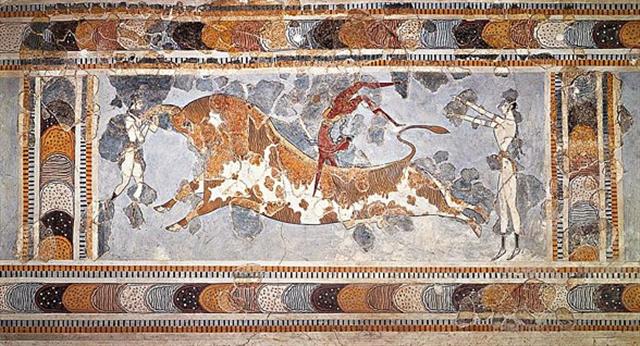258. From the death
of Captain Cook in All Heart's Day (2-14,
day 45 = 360 / 8) to ε
('Elsie') down in the Well ('Tea-pot'), i.e.
from the Leopard at Nash (γ Sagittarii) to
the Tapir at μ Gemini (Tejat Posterior),
there were 365 + 175 - 353 = 187 (183 + 4)
days. 187 + 178 = 365.
|
1 |
Horn |
α Virginis (Spica) |
Crocodile |
(202.7) |
Oct 9 (282) |
|
2 |
Neck |
κ Virginis |
Dragon |
(214.8) |
Oct 21 (294) |
|
3 |
Root |
α Librae (Zuben Elgenubi) |
Badger |
(224.2) |
Oct 31 (304) |
|
4 |
Room |
π Scorpii (Vrischika) |
Hare |
(241.3) |
Nov 17 (321) |
|
5 |
Heart |
σ Scorpii |
Fox |
(247.0) |
Nov 23 (327) |
|
6 |
Tail |
μ Scorpii (Denebakrab) |
Tiger |
(254.7) |
Nov 30 (334) |
|
7 |
Winnowing Basket |
γ Sagittarii (Nash) |
Leopard |
(273.7) |
Dec 19 (353) |
|
December solstice |
|
8 |
South Dipper |
φ Sagittarii (?) |
Unicorn |
(284.0) |
Dec 30 (364) |
|
9 |
Ox / Herd Boy |
β Capricornii (Dabih) |
Buffalo |
(308.0) |
Jan 23 (388) |
|
10 |
Girl |
ε Aquarii (Albali) |
Bat |
(314.8) |
Jan 29 (394) |
|
11 |
Emptiness |
β Aquarii (Sadalsud) |
Rat |
(325.9) |
Feb 9 (405) |
|
12 |
Rooftop |
α Aquarii (Sadalmelik) |
Swallow |
(334.6) |
Feb
18 (414) |
|
13 |
House |
α Pegasi (Markab) |
Pig |
(349.5) |
Mar 5 (429) |
|
March equinox |
|
14 |
Wall |
γ Pegasi (Algenib) |
Porcupine |
(1.8) |
Mar 22 (81) |
|
15 |
Legs |
η Andromedae (?) |
Wolf |
(11.4) |
Apr 1 (91) |
|
16 |
Bond |
β Arietis (Sheratan) |
Dog |
(27.4) |
Apr 17 (107) |
|
17 |
Stomach |
4¹ Arietis (Bharani) |
Pheasant |
(41.4) |
May 1 (121) |
|
18 |
Hairy Head |
η Tauri (Alcyone) (?) |
Cockerel |
(56.1) |
May 16 (136) |
|
19 |
Net |
ε Tauri (Ain) |
Crow |
(65.7) |
May
25 (145) |
|
20 |
Turtle Head |
λ Orionis (Heka) |
Monkey |
(83.2) |
Jun 12 (163) |
|
21 |
Three Stars |
ζ Orionis (Alnitak) |
Gibbon |
(84.7) |
Jun 13 (164) |
|
June solstice |
|
22 |
Well |
μ Gemini (Tejat Posterior) |
Tapir |
(95.4) |
Jun 24 (175) |
|
23 |
Ghost |
ρ Gemini ? |
Goat |
(112.1) |
Jul
11 (192) |
|
24 |
Willow |
δ Hydrae |
Stag |
(129.6) |
Jul 28 (209) |
|
25 |
Star |
α Hydrae (Alphard) |
Horse |
(142.3) |
Aug 10 (222) |
|
26 |
Extended Net |
ε Hydrae / μ Hydrae |
Ox |
(131.9 / 157.1) |
Jul 30 (211) /
Aug
25 (237) |
|
27 |
Wings |
α Crateris (Alkes) |
Snake |
(165.6) |
Sep 2 (245) |
|
28 |
Chariot |
γ Corvi (Gienah) |
Worm |
(185.1) |
Sep 22 (265) |
|
September equinox |
... 'Tell us a story!' said
the March Hare. 'Yes, please
do!' pleaded Alice. 'And be
quick about it', added the
Hatter, 'or you'll be asleep
again before it's done.'
'Once upon a time there were
three little sisters', the
Dormouse began in a great
hurry: 'and their names were
Elsie [ε], Lacie [λ], and Tillie
[τ];
and they lived at the bottom
of a well —
'
|
10 Febr |
11 |
12 (408) |
13 |
2-14 (40 + 5) |
15 |
|
... Nevertheless, by virtue of a
series of spectacular
coincidences, Cook made a
near-perfect ritual exit on the
night of 3 February. The timing
itself was nearly perfect, since
the Makahiki rituals
would end 1 February (±1 day),
being the 14th day of the second
Hawaiian month [Kau-lua].
This helps explain Mr. King's
entry for 2 February in the
published Voyage: 'Terreoboo [Kalaniopu'u]
and his Chiefs, had, for some
days past, been very inquisitive
abouth the time of our
departure' - to which his
private journal adds, '& seem'd
well pleas'd that it was soon'.
Captain Cook, responding to
Hawaiian importunities to leave
behind his 'son', Mr. King
[sic!], had even assured
Kalaniopu'u and the high
priest that he would come back
again
the following year. Long after
they had killed him, the
Hawaiians continued to believe
this would happen. Hence the
ultimate ritual coincidence,
which was meteorological: one of
the fertilizing storms of
winter, associated with the
advent of Lono, wreaked havoc
with the foremast of the
Resolution, and the British were
forced to return to Kealakekua
for repairs on 11 February
1779 ... Mr. King remarks that
there were not as many hundreds
of people at their return to
Kealakekua as there had been
thousands when they first came
in. A tabu was in effect, which
was ascribed to the king's
absence. By the best evidence,
the British had interrupted the
annual bonito-fishing rite, the
transition
from the Makahiki season to
normal temple ceremonies. Cook
was now hors cadre. And
things fell apart ...
... Early on Sunday morning,
14 February
1779, Captain Cook went ashore
with a party of marines to take
the Hawaiian king, Kalaniopu'u,
hostage against the return of
the Discovery's cutter, stolen
the night before in a bold
maneuver - of which, however,
the amiable old ruler was
innocent. At the decisive
moment, Cook and Kalaniopu'u,
the God and the King, will
confront each other as cosmic
adversaries. Permit me thus an
anthropological reading of the
historical texts. For in all the
confused Tolstoian narratives of
the affray - among which the
judicious Beaglehole refuses to
choose - the one recurrent
certainty is a dramatic
structure with the properties of
a ritual transformation. During
the passage inland to find the
king, thence seaward with his
royal hostage, Cook is
metamorphosed from a being of
veneration to an object of
hostility. When he came ashore,
the common people as usual
dispersed before him and
prostrated face to earth; but in
the end he was himself
precipitated face down in the
water by a chief's weapon, an
iron trade dagger, to be rushed
upon by a mob exulting over him,
and seeming to add to their own
honors by the part they could
claim in his death: 'snatching
the daggers from each other',
reads Mr. Burney's account, 'out
of eagerness to have their share
in killing him'. In the final
ritual inversion, Cook's body
would be offered in sacrifice by
the Hawaiian King
... |
 |
 |
 |
 |
 |
 |
|
Cb10-13 |
Cb10-14 (636) |
Cb10-15 |
Cb10-16 |
Cb10-17 |
Cb10-18 (248) |
|
te moa nui -
kua vaha |
te hokohuki-
te mata |
te matagi ma te rau hei |
te hokohuki -
te moko |
te kava - te
hokohuki |
te kihikihi i
te rima o te tagata |
|
Matagi.
Wind, air,
breeze, squall, tempest, rhumb.
P Pau.: matagi, the air,
wind. Mgv.: matagi, wind.
Mq.: metani, metaki,
wind, air. Ta.: matai,
wind. Churchill.

... A une certaine saison, on
amassait des vivres, on faissait
fête. On emmaillottait un
corail, pierre de defunt lézard,
on l'enterrait, tanu.
Cette cérémonie était un point
de départ pour beaucoup
d'affaires, notamment de
vacances pour le chant des
tablettes ou de la prière,
tanu i te tau moko o tana pure,
enterrer la pierre sépulcrale du
lézard de sa prière
... |
|
μ Columbae,
SAIPH (Sword) = κ Orionis
(86.5), τ Aurigae, ζ Leporis
(86.6) |
υ Aurigae (87.1), ν Aurigae
(87.2),
WEZN (Weight) = β Columbae,
δ Leporis (87.7),
TZE (Son) = λ Columbae
(87.9) |
Ardra-6 (The Moist One) /
ANA-VARU-8 (Pillar to sit by)
χ¹ Orionis, ξ Aurigae (88.1),
BETELGEUZE
(House of the Giant) = α Orionis
(88.3), ξ Columbae (88.5), σ
Columbae (88.7)
ZUBEN ELGENUBI (α Librae
|
η Leporis (89.0),
PRAJA-PĀTI
(Lord of Created Beings) = δ
Aurigae,
MENKALINAN (Shoulder of the
Rein-holder) = β Aurigae,
MAHASHIM (Wrist) = θ Aurigae,
and γ Columbae (89.3), π Aurigae
(89.4), η Columbae (89.7) |
μ Orionis (90.3), χ² Orionis
(90.5) |
6h (91.3)
ν Orionis (91.4), θ Columbae
(91.5), π Columbae (91.6)
|
|
MULIPHEN
(Oaths) = γ Ophiuchi
(269.0),
BASANISMUS = G Scorpii
(269.5),
PHERKARD (The Dim One of the Two
Calves) = δ Ursae Minoris
(269.9) |
PTOLEMY
CLUSTER = M7 Scorpii
(270.5),
GRUMIUM (Lower Jaw) = ξ Draconis
(270.9) |
RUKBALGETHI GENUBI (Bending
Claw) = θ Herculis
(271.1), ξ Herculis (271.5),
ETAMIN
(Head) =γ Draconis, ν
Herculis (271.7), ν Ophiuchi
(271.8) |
Cat's Eye = NGC6543 Draconis
(272.2), ζ Serpentis (272.4), τ
Ophiuchi (272.9) |
Winnowing Basket-7 (Leopard)
18h (273.4)
NASH
(Point) = γ Sagittarii
(273.7), θ Arae (273.8) |
ZHŌNGSHĀN
= ο Herculis (274.0), π
Pavonis (274.6) |
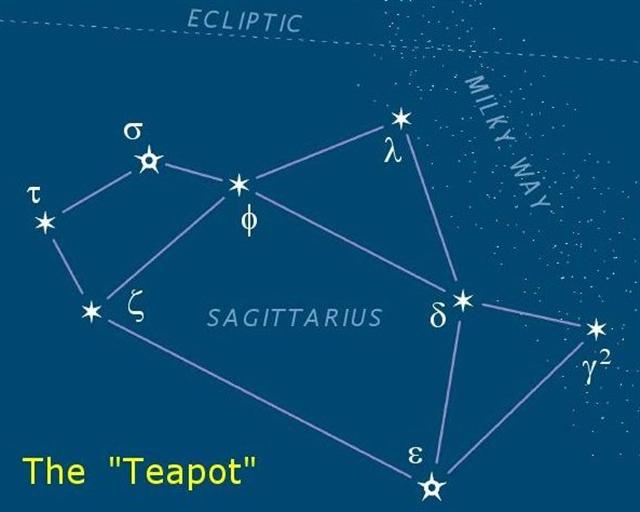
... As has already been
mentioned, the Delphians
worshipped Dionysus once a year
as the new-born child,
Liknites, 'the Child in the
Harvest Basket', which was a
shovel-shaped basket of rush and
osier used as a harvest basket,
a cradle, a manger, and a
winnowing-fan for tossing the
grain up into the air against
the wind, to separate it from
the chaff. The worship of the
Divine Child was established in
Minoan Crete, its most famous
early home in Europe. In 1903,
on the site of the temple of
Dictaean Zeues - the Zeus who
was yearly born in Rhea's cave
at Dicte near Cnossos, where
Pythagoras spent 'thrice nine
hallowed days' [27] of his
initiation - was found a Greek
hymn which seems to preserve the
original Minoan formula in which
the gypsum-powdered,
sword-dancing Curetes, or
tutors, saluted the Child at his
birthday feast. In it he is
hailed as 'the Cronian one' who
comes yearly to Dicte mounted on
a sow and escorted by a
spirit-throng, and begged for
peace and plenty as a reward for
their joyful leaps ...
 |
|
... Beyond the 'death' (sacrifice,
rau hei) of Lono a tribute-canoe of
offerings was set adrift for
Kahiki (Tahiti),
homeland of the gods, and the
first star in Argo Navis (viz.
Canopus, *95) was at the Sun 5
days after this basket / cradle
/ coracle, rising heliacally in
June 24 (80 + *95) = St John's
Day and half a year away from
Christmas Eve.
... Gronw Pebyr, who figures as
the lord of Penllyn - 'Lord of
the Lake' - which was also the
title of Tegid Voel, Cerridwen's
husband, is really Llew's twin
and tanist ... Gronw reigns
during the second half of the
year, after Llew's sacrificial
murder; and the weary stag whom
he kills and flays outside
Llew's castle stands for Llew
himself (a 'stag of seven
fights'). This constant shift in
symbolic values makes the
allegory difficult for the
prose-minded reader to follow,
but to the poet who remembers
the fate of the pastoral
Hercules the sense is clear:
after despatching Llew with the
dart hurled at him from Bryn
Kyvergyr, Gronw flays him, cuts
him to pieces and distributes
the pieces among his merry-men.
The clue is given in the phrase
'baiting his dogs'. Math had
similarly made a
stag of his rival Gilvaethwy,
earlier in the story. It seems
likely that Llew's mediaeval
successor, Red Robin Hood, was
also once worshipped as a stag.
His presence at the Abbot's
Bromley Horn Dance would be
difficult to account for
otherwise, and 'stag's horn'
moss is sometimes called 'Robin
Hood's Hatband'. In May, the
stag puts on his red summer coat.
Llew visits the Castle of
Arianrhod [Corona Borealis] in a
coracle of weed and sedge. The
coracle is the same old harvest
basket in which nearly every
antique Sun-god makes his New
Year voyage; and the virgin
princess, his mother, is always
waiting to greet him on the bank
...
 |
|
|
|
16 Febr (412) |
(14 * 29½) |
18 (643 -
229) |
19 (50) |
20 |
21 |
 |
 |
 |
 |
 |
 |
|
Cb10-19 |
Cb10-20 (642) |
Cb10-21 |
Cb10-22 (202 + 50) |
Cb11-1 |
Cb11-2 (254) |
|
te
hokohuki - manu rere |
te
kihikihi o te marama |
te maro o
te henua |
kua vero |
Te
kihikihi - tagata moe |
ki te
ariki - te hokohuki |
|
Probably
Metoro said kua vero
in order to inform Bishop
Jaussen on Tahiti where
Christmas was located in the
text, viz. 183 days after St
John's Day. |
|
ξ Orionis (92.5) |
Al Han'ah-4 (Brand) /
Maru-sha-pu-u-mash-mashu-7
(Front of the Mouth of the
Twins)
TEJAT PRIOR = η Gemini
(93.4), γ Monocerotis
(93.5), κ Aurigae (93.6), κ
Columbae (93.8) |
FURUD = ζ Canis Majoris
(94.9) |
Well-22 (Tapir) /
Arkū-sha-pu-u-mash-mashu-8
(Back of the Mouth of the
Twins)
δ Columbae (95.2),
TEJAT POSTERIOR = μ Gemini,
MIRZAM ('Roarer') = β Canis
Majoris
(95.4),
CANOPUS
= α Carinae
(95.6), ε Monocerotis
(95.7), ψ1 Aurigae (95.9) |
no star listed (96) |
β Monocerotis, ν Gemini
(97.0) |
|
Solstice |
June 22 (193 - 20) |
23 |
ST JOHN'S DAY |
25 |
26 (354 / 2) |

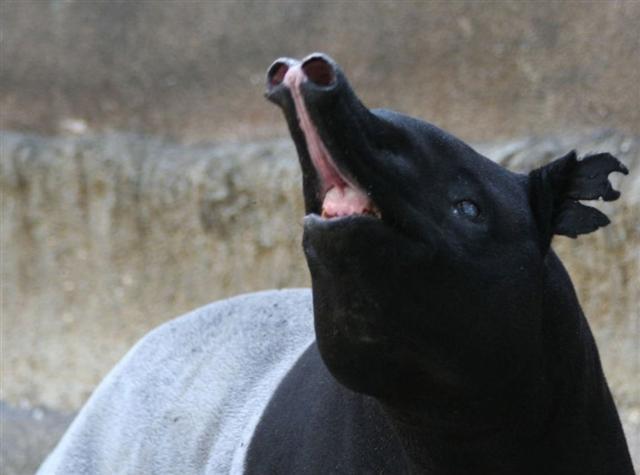 |
|
ι Pavonis (275.1),
POLIS
= μ Sagittarii
(275.9)
MENKAR (α Ceti)
|
η Sagittarii (276.9) |
Purva Ashadha-20
(Winnowing basket) |
KAUS
BOREALIS = Λ(acie) Sagittarii
(279.3) |
ν Pavonis (280.4), κ Cor.
Austr. (280.9) |
|
KAUS
MEDIUS = δ Sagittarii,
κ Lyrae (277.5),
TUNG
HAE (Heavenly Eastern Sea) =
η Serpentis (277.7),
SHAOU
PIH (Minor Minister) = φ
Draconis (277.8),
KWEI
SHE = χ Draconis
(277.9) |
φ Oct. (278.1),
KAUS AUSTRALIS = Ε(lsie)
Sagittarii
(278.3), ξ Pavonis
(278.4),
AL
ATHFAR (The Talons of the
Falling Eagle) = μ Lyrae
(278.6) |
|
Solstice |
Dec 22 |
23 |
X-MAS EVE |
25 |
26 (360) |
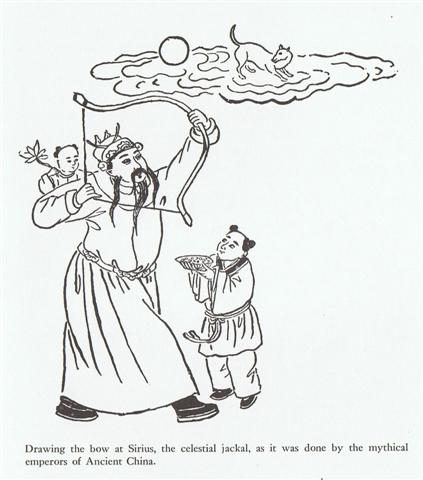
Sirius was
well below the equator and
instead of aiming an Arrow
up towards the sky its pair
of complementary parts, viz.
the String and the Bow, should
be used. Which also explains
why the arrow head of
Sagittarius (below 10°
S) was in the Milky
Way River:
 |
'Tillie' (τ
Sagittarii) was the last star in the
South Dipper:
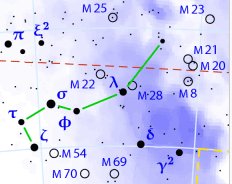
|
25 Febr |
26 |
22-7 (2 * 29) |
28 (59) |
1 March |
2 (426) |
 |
 |
 |
 |
 |
 |
|
(639 + 11 = 650) |
Cb11-7 |
Cb11-8 (260) |
Cb11-9 (9 * 29) |
Cb11-10 |
Cb11-11
(→ 11²) |
|
Tagata hua
hakahitihiti |
koia kua tu |
vai o ako hia |
te
manu |
tere te marama |
te
ariki |
|
Ako.
To
sing, to recite:
he-ako i te kaikai,
to recite the [text
accompanying a]
string figure
kaikai;
he-ako i te rîu,
to sing rîu.
Vanaga. Song. Ako
hakaha'uru poki
= 'song to make
children sleep'.
Barthel.
Ákoáko,
to recite hymns in
honour of a deity.
Vanaga. |
|
Dec 30 (*284) |
31 (*26 + *259) |
Jan 1
(366) |
2 |
3 |
4 (= 426 - 57) |
|
21 Oct (*214) |
22 (*26 + *189) |
23
(296) |
24 |
25 |
26 (= 426 - 127) |
|
South Dipper-8
(Unicorn)
Φ Sagittarii (284.0),
μ Cor. Austr.
(284.6), η Cor.
Austr., θ Pavonis
(284.8) |
SHELIAK (Tortoise) =
β Lyrae,
ν Lyrae (285.1), ο
Draconis (285.5). λ
Pavonis (285.7)
ATLAS (27 Tauri)
|
χ Oct. (286.0),
AIN AL RAMI
(Eye of the Archer)
= ν Sagittarii
(286.2), υ Draconis
(286.4), δ Lyrae
(286.3), κ Pavonis
(286.5),
ALYA
(Fat Tail) = θ
Serpentis
(286.6) |
ξ Sagittarii
(287.1), ω Pavonis
(287.3), ε Aquilae,
ε Cor. Austr.,
SULAPHAT (Little
Tortoise Shell) = γ
Lyrae
(287.4), λ Lyrae
(287.7),
ASCELLA
(Armpit) = ζ
Sagittarii,
BERED =
ι Aquilae
(Ant.)
(287.9) |
Al Na'ām-18
(Ostriches) /
Uttara Ashadha-21
(Elephant tusk,
small bed)
NUNKI = σ Sagittarii
(288.4), ζ Cor.
Austr. (288.5),
MANUBRIUM = ο
Sagittarii
(288.8), ζ Aquilae
(288.9) |
19h (289.2)
λ Aquilae (Ant.)
(289.1), γ Cor.
Austr (289.3),
τillie
Sagittarii
(289.4), ι Lyrae
(289.5), δ Cor.
Austr. (289.8)
|
|
... This [σ
Sagittarii] has been
identified with
Nunki of the
Euphratean Tablet
of the Thirty Stars,
the Star of the
Proclamation of the
Sea, this Sea
being the quarter
occupied by
Aquarius,
Capricornus,
Delphinus, Pisces,
and Pisces
Australis. It is the
same space in the
sky that Aratos
designated as
Water ...
... The most
important of all
drums, he said, was
the armpit drum. The
Nummo made it. It
consists of two
hemispherical wooden
cups connected
through their
centres by a slender
cylinder. It is like
an hour-glass with a
very long narrow
neck. With this
instrument tucked
between his left arm
and armpit, the
drummer, by pressing
on the hollow
structure of thin
wood, can tighten or
relax the tension on
the skins and so
modify the tone.
'The Nummo made it.
He made a picture of
it with his fingers,
as children do today
in games with
string.' Holding his
hands apart, he
passed a thread ten
times round each of
the four fingers,
but not the thumb.
He thus had forty
loops on each hand,
making eighty
threads in all,
which, he pointed
out, was also the
number of teeth of
his jaws. The palms
of his hands
represented the
skins of the drum,
and thus to play on
the drum was,
symbolically, to
play on the hands of
the Nummo
... |
|
... θ is the last
star in the Ara
constellation, and
the ancient meaning
of this letter was
described as a wheel
by the Phoenicians
but for the Egyptian
it meant 'good'.
When the wheel of
time has come full
cycle around and the
upside down
fire-altar is in the
past the times ahead
should be good (or
lucky Sa'ad)
...
"... Alya ...
this title belonging
by universal
recognition to
another θ¹ [than θ¹
in Taurus], - that
of Serpens ..."
(Allen)
"It (θ¹ Serpentis)
is the terminal star
in the Serpent ..."
(Allen)
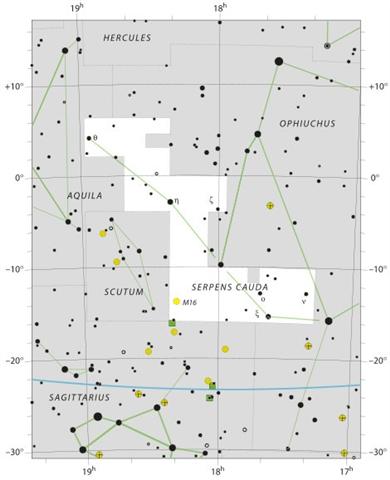
 |
It seems
reasonable to use the
facts above as a kind of confirmation
of my assumption that
the beginning of side a
on the C tablet was
designed to coincide
with the time around southern spring
equinox:
|
no glyph (day
zero) |
17 Nov (264 +
57) |
18 (82 + 240) |
19 (323) |
*4 + *240 |
21 (325, *245) |
22 (326) |
 |
 |
 |
 |
 |
 |
|
Ca1-1 |
Ca1-2 |
Ca1-3 |
Ca1-4 |
Ca1-5 |
Ca1-6 |
|
koia |
ki te hoea
(instrument for
tattooing) |
ki te henua |
te rima te
hau tea |
haga i te mea
ke |
ki te henua -
tagata honui |
|
Al
Fargh al
Thāni-25 (Rear
Spout)
0h (*366)
CAPH
(Hand) = β
Cassiopeiae,
SIRRAH
(Navel of the
Horse) = α
Andromedae
(0.5), ε
Phoenicis, γ³
Oct. (0.8) |
Uttara Bhādrapadā-27
(2nd of the
Blessed Feet) /
Wall-14
(Porcupine)
ο Oct. (1.3),
ALGENIB PEGASI
= γ Pegasi
(1.8) |
χ Pegasi (2.1),
θ Andromedae
(2.7) |
σ Andromedae
(3.0), ι Ceti
(3.3), ζ Tucanae
(3.5), ρ
Andromedae, π
Tucanae (3.7) |
no star listed
(4) |
ANKAA = α
Phoenicis,
κ Phoenicis
(5.0)
ALPHARD (α
Hydrae) |
λ Phoenicis
(6.3), β Tucanae
(6.4) |
|
March 21 |
22 (*1) |
23 |
24 |
Julian equinox |
26 (85) |
(*6 = *246 -
*240) |
|
Sept 20
(*183) |
*184 |
Equinox |
266 |
Acrux |
*188 |
*189 (= *246 -
*57) |
|
23 Nov (327) |
24 |
25 |
26 (*250) |
 |
 |
 |
 |
|
Ca1-7 |
Ca1-8 |
Ca1-9 |
Ca1-10 |
|
te ika |
te honu |
te manu te
henua |
|
ANDROMEDA GALAXY
(M31),
π Andromedae
(7.7) |
ε Andromedae
(8.2),
DELTA = δ
Andromedae
(8.4),
SCHEDIR (Breast)
= α Cassiopeiae
(8.6), ζ
Andromedae, μ
Phoenicis (8.9) |
ξ Phoenicis
(9.0), ρ Tucanae
(9.1),
DENEB
KAITOS (Tail of
the Sea Beast) =
β Ceti,
η Phoenicis
(9.4),
AL NITHĀM
(String of
Pearls)
= φ¹ Ceti (9.6) |
ACHIRD (Woman
with Luminous
Rays) = η
Cassiopeiae
(10.7) |
|
March 28 |
29 |
30 |
31 (90 = 330 -
183 - 57) |
|
*190 |
Porrima |
*192 |
30 (273 = 330 -
57) |
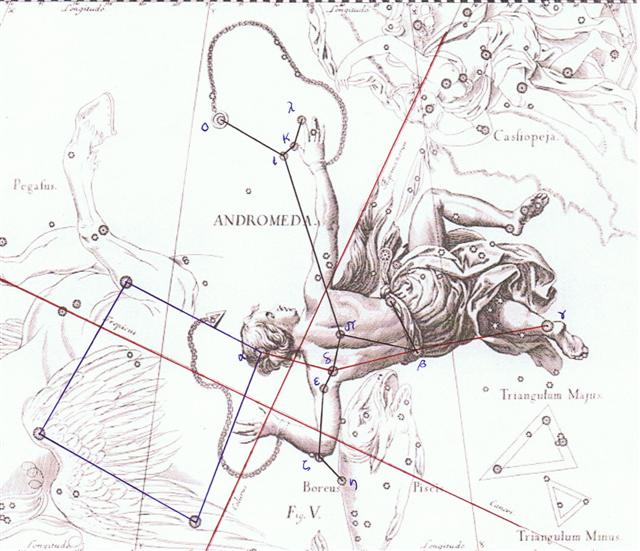

|























